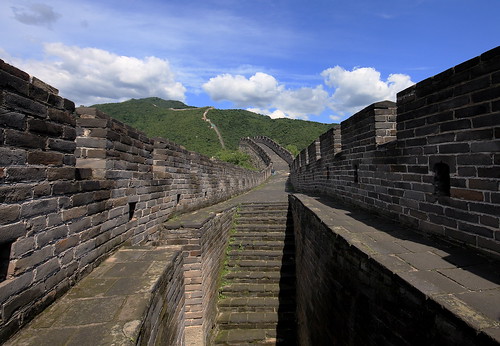Construction Material of the Great Wall
As we all know, the Great Wall is the treasure of China - even the world. It really is a great masterpiece of mankind, with its beautiful scenes and grand construction. What many people may not know, however, is that in different periods of Chinese history the material of the Great Wall is different in different areas.
Before the use of bricks, the Great Wall was mainly built from earth, stones and wood. Due to the large quantity of materials required to construct the Great Wall, the builders always tried to use local sources. When building over the mountain ranges, the stones of the mountain were exploited and used; while in the plains, earth was rammed into solid blocks to be used in construction. In the desert, even the sanded reeds and juniper tamarisks were used to build the Great Wall.
Before and during the Qin Dynasty (221BC-206BC), because the earth buildings could withstand the strength of weapons like swords and spears and there was low technology of productivity, the Great Wall was basically built by stamping earth between board frames. As such, only walls of plain earth or earth with gravel inside were built. No fortresses were constructed along the wall, nor bricks used in the construction of gates at the passes. Some of the walls were even made only from piles of crude stones. Around Dunhuang City in Gansu Province, Yulin City in Shaanxi Province and Baotou City in Inner Mongolia, sites can still be found from the Great Wall of Qin, the Great Wall of Han and the Wall of Zhao. The Wall of Zhao was built during the Warring States Period using board frames, and the layers of earth can still be clearly seen.
During the period following the Han Dynasty (202BC-220AD), earth or crude stones were still popular building tools. The construction material did not reach a new level until the middle of the Ming Dynasty (1368-1644); however the principle of using local material was maintained. Three hundred million cubic meters (393 million yards) of earthwork were used in the construction of the Great Wall, and with the appearance of large brick and lime workshops, some parts were also built with these new materials.
Bricks were used in a lot of areas during the Ming Dynasty, as well as materials such as tiles and lime. Attempts were always made to produce the materials locally, so kiln workshops were established to burn the crude material. In a construction team there was Material Supply Department. For example, in Juyongguan Pass names of supply departments such as kiln workshops, stone ponds and material supply departments were recorded. Some materials, such as the timbers for the construction of the passes, did have to be transported from outside areas when there were none available locally.
Bricks were more a convenient material than earth and stone as their small size and light weight made them convenient to carry and thus quickened the speed of construction. Bricks are also the ideal material to bear the weight. According to a sample experiment experiencing gravity and erosion over a hundred years, the compressive strength, resistance to freezing and absorbency of the bricks of the time are similar to today's common bricks. A huge brick from a hundred years ago showed a high level of technological skill for that time. For further ease of construction, different shapes of brick were also burned and made to stuff into different positions.
Stone, however, still has its advantages. Stones cut in rectangular shapes were mostly used to build the foundation, inner and outer brims, and gateways of the Great Wall. In the Badaling section, the Great Wall is made almost entirely of granite, some of green and white stones and some of white marble. The stone material was found to better resist efflorescence than bricks.
It is not only because of the high level of productivity of the time that hard material like bricks and stones were used in the construction of the Great Wall, but also because of the development of weapons. Before the Ming Dynasty, the Great Wall was built from board frames and, although not very solid, could withhold simple weapons like swords, spears and bows. But during the Ming Dynasty, gunpowder became available. The musket, blunderbuss and cannon appeared. Due to the use of these weapons, more solid bricks and stones were required to build a stronger Great Wall.
The Great Wall of China embodies the great systems of defense created during the wars of the time; moreover it indicates a great achievement in architecture.
Construction Material of the Great Wall

the Great Wall

the Great Wall of China

pictures of the Great Wall


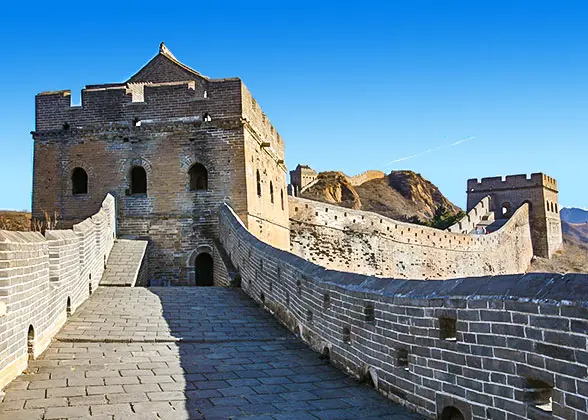 Beacon towers : Beacon towers were used for passing military messages. They were often built on the tops of the mountains or rises for convenience in watching the enemies’ movements. Due to its unique function, it is regarded as the oldest effective telegraph system in Chinese history.
Beacon towers : Beacon towers were used for passing military messages. They were often built on the tops of the mountains or rises for convenience in watching the enemies’ movements. Due to its unique function, it is regarded as the oldest effective telegraph system in Chinese history.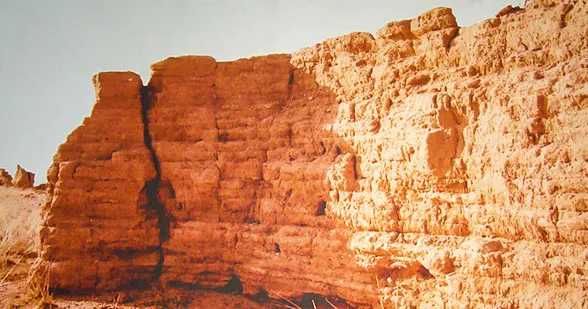 Walls : Walls are the main part of the construction, averaging about 26.6 feet tall. They serve as the important nexus connecting the passes, beacon towers, watch towers and other military structures together, thus allowing the dragon to fly freely over the vast land of northern China.
Walls : Walls are the main part of the construction, averaging about 26.6 feet tall. They serve as the important nexus connecting the passes, beacon towers, watch towers and other military structures together, thus allowing the dragon to fly freely over the vast land of northern China.
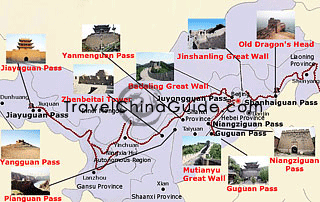
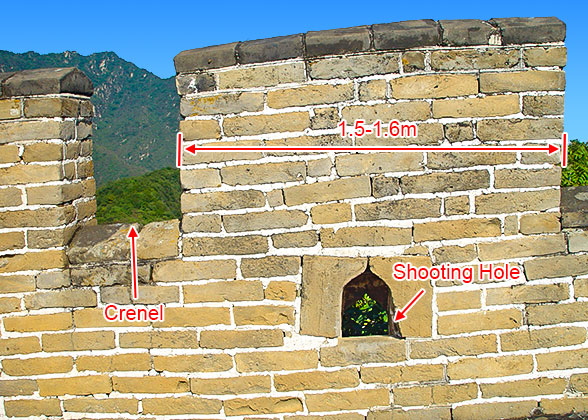 The Qin Wall starts from Liaodong (today's east and south of Liaoning Province) in the east and ends at Lintao (today's Lintao County in Gansu Province) in the west. The wall was built according to the local conditions and used local materials. Generally speaking, the Qin Wall was made of large pieces of stones. Between the stones, huge amounts of detritus was accumulated and filled in. It measures about 4.4 to 5.5 yards. The steep cliffs were used as natural walls after being chiseled a little. In Gobi area, the wall was built by mixing grit with the local plants such as red willows, reeds, and poplars. In flat plains, the wall was built from pounded yellow earth, layer upon layer. Besides connecting the scattered sections of previous states, Qin Wall was augmented with rather complicated military structures such as blockhouses, barriers, passes and beacon towers.
The Qin Wall starts from Liaodong (today's east and south of Liaoning Province) in the east and ends at Lintao (today's Lintao County in Gansu Province) in the west. The wall was built according to the local conditions and used local materials. Generally speaking, the Qin Wall was made of large pieces of stones. Between the stones, huge amounts of detritus was accumulated and filled in. It measures about 4.4 to 5.5 yards. The steep cliffs were used as natural walls after being chiseled a little. In Gobi area, the wall was built by mixing grit with the local plants such as red willows, reeds, and poplars. In flat plains, the wall was built from pounded yellow earth, layer upon layer. Besides connecting the scattered sections of previous states, Qin Wall was augmented with rather complicated military structures such as blockhouses, barriers, passes and beacon towers.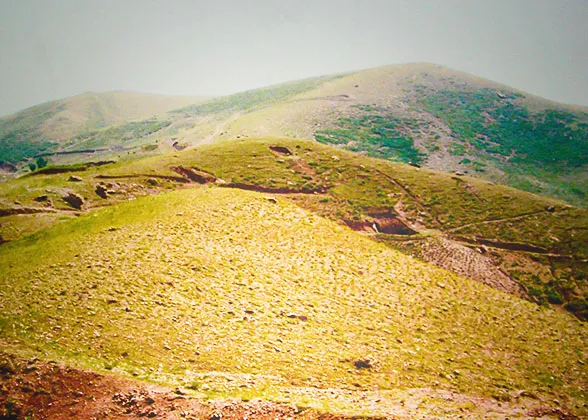 Han Wall followed the basic characteristic of Qin Wall, that is, to build the wall according to the local conditions and used local materials. The difference lies in the constructional types. The Han Wall mainly wound through grasslands where big stones were not available. The compressed earth construction was favored. For example, in Dunhuang, where large amount of bulrush, poplar, red willow and dogbane grew, these were used for wall construction. The branches of these plants served as groundwork which was covered by a layer of sun-dried mud bricks mixed with grit and above was the rammed bulrush. On average, the thickness of the bulrush layer measured 1.6 to 2.0 inches and the grit layer measured 7.9 inches. Remnants of this work remain till this day. The willow branch and bulrush could bear strong tension, and stones and grit were not easy to be destroyed after being compacted in layers, so the wall became rather solid.
Han Wall followed the basic characteristic of Qin Wall, that is, to build the wall according to the local conditions and used local materials. The difference lies in the constructional types. The Han Wall mainly wound through grasslands where big stones were not available. The compressed earth construction was favored. For example, in Dunhuang, where large amount of bulrush, poplar, red willow and dogbane grew, these were used for wall construction. The branches of these plants served as groundwork which was covered by a layer of sun-dried mud bricks mixed with grit and above was the rammed bulrush. On average, the thickness of the bulrush layer measured 1.6 to 2.0 inches and the grit layer measured 7.9 inches. Remnants of this work remain till this day. The willow branch and bulrush could bear strong tension, and stones and grit were not easy to be destroyed after being compacted in layers, so the wall became rather solid.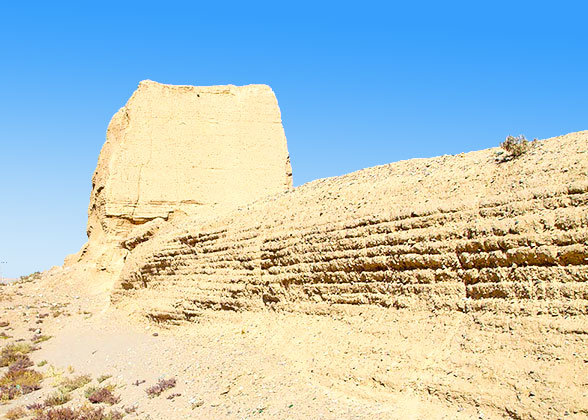 The military system of Han Wall included barriers, beacon towers, strongholds, trenches, castles besides passes and blockhouses. Tiantian, a newly created observation object, was built by placing a layer of silver sand inside the trench. If the Huns dared to set foot in, they would certainly leave footprint on the sand, which would be noticed by sentries. Besides, the strict beacon system was formed in Han Dynasty. The regulation prescribed that a beacon be built at the interval of 1.6 miles, a block at the interval of 3.1 miles, a fortress at the interval of 18.6 miles and a pass at the interval of 62.1 miles. In the daytime, smoke columns were used to warn the coming of attacks. One smoke column indicated that less than one thousand enemies invaded, if more than one thousand enemies attacked, two smoke columns would be raised. Three smoke columns would be lifted in case more enemies came. At night, soldiers would kindle firebrands to warn of coming dangers.
The military system of Han Wall included barriers, beacon towers, strongholds, trenches, castles besides passes and blockhouses. Tiantian, a newly created observation object, was built by placing a layer of silver sand inside the trench. If the Huns dared to set foot in, they would certainly leave footprint on the sand, which would be noticed by sentries. Besides, the strict beacon system was formed in Han Dynasty. The regulation prescribed that a beacon be built at the interval of 1.6 miles, a block at the interval of 3.1 miles, a fortress at the interval of 18.6 miles and a pass at the interval of 62.1 miles. In the daytime, smoke columns were used to warn the coming of attacks. One smoke column indicated that less than one thousand enemies invaded, if more than one thousand enemies attacked, two smoke columns would be raised. Three smoke columns would be lifted in case more enemies came. At night, soldiers would kindle firebrands to warn of coming dangers.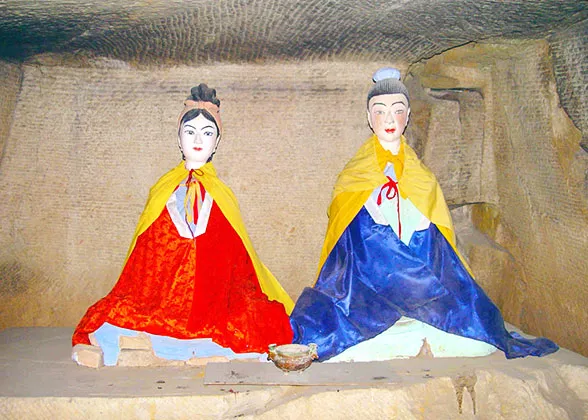 The Ming Wall is the solidest and most complete one compared with walls in other dynasties. The Ming Dynasty drew the experience from the previous dynasties when they built the wall. More important military fortifications were added on the wall. In flat areas, outside the wall, big wide moats were dug to make approach difficult.
The Ming Wall is the solidest and most complete one compared with walls in other dynasties. The Ming Dynasty drew the experience from the previous dynasties when they built the wall. More important military fortifications were added on the wall. In flat areas, outside the wall, big wide moats were dug to make approach difficult.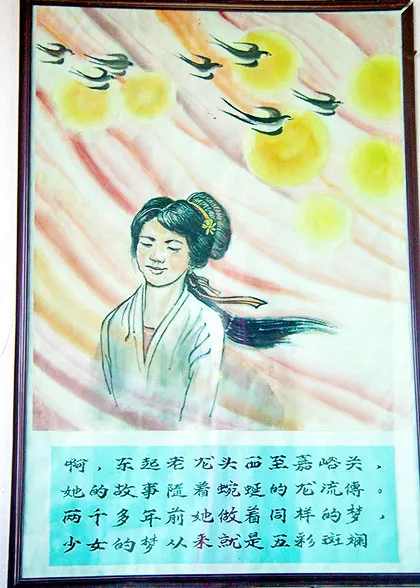 Watch towers were often square in shape and towered above the top of the wall about 13.1 feet. While at places of strategical importance, the watch towers were round and raised high above the wall. They were built for soldiers to live in, to store food and weapons for a long period of time. The Ming Dynasty still raised smoke to warn of dangers. Besides, the boom of cannon was added to strengthen the alarm effect. In ancient times when telephone and wireless communication were not available, this method to transfer the military message was obviously fast. Beacon towers in Ming Wall were also used for ensuring the safety of ambassadors, supplying them with room and board and offering forage for their horses.
Watch towers were often square in shape and towered above the top of the wall about 13.1 feet. While at places of strategical importance, the watch towers were round and raised high above the wall. They were built for soldiers to live in, to store food and weapons for a long period of time. The Ming Dynasty still raised smoke to warn of dangers. Besides, the boom of cannon was added to strengthen the alarm effect. In ancient times when telephone and wireless communication were not available, this method to transfer the military message was obviously fast. Beacon towers in Ming Wall were also used for ensuring the safety of ambassadors, supplying them with room and board and offering forage for their horses.





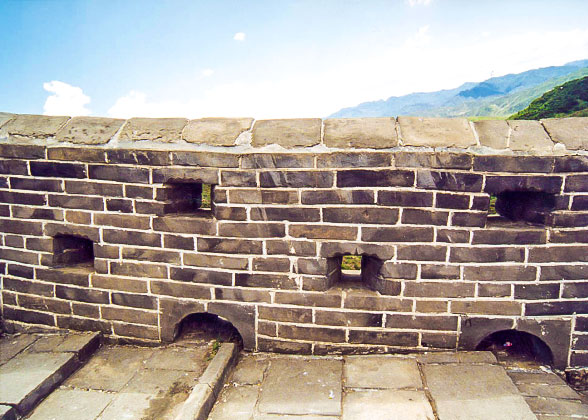 The winding Great Wall is not merely a wall but instead a complete and rigorous defense project composed of countless passes, watchtowers, garrison towns, beacon towers and blockhouses. These fortifications were arranged in certain ways under the control of the military command system at all levels. For example, there were about 1,000,000 soldiers guarding the Ming’s wall. The chief military officers were stationed in garrison-towns, while lesser officials and soldiers were stationed in Guan Cheng (the defensive beachhead) and other smaller fortifications. The eleven garrisons were set up along the wall in order to guard the precinct or subsection. The average height of the Ming wall measures 33 feet and the width is about five yards. In low, flat areas the wall was built high and more defense lines were added. In the lofty mountains, the wall was a little lower in order to save the human and financial cost. Sometimes, even steep cliffs served as natural walls to thwart enemies.
The winding Great Wall is not merely a wall but instead a complete and rigorous defense project composed of countless passes, watchtowers, garrison towns, beacon towers and blockhouses. These fortifications were arranged in certain ways under the control of the military command system at all levels. For example, there were about 1,000,000 soldiers guarding the Ming’s wall. The chief military officers were stationed in garrison-towns, while lesser officials and soldiers were stationed in Guan Cheng (the defensive beachhead) and other smaller fortifications. The eleven garrisons were set up along the wall in order to guard the precinct or subsection. The average height of the Ming wall measures 33 feet and the width is about five yards. In low, flat areas the wall was built high and more defense lines were added. In the lofty mountains, the wall was a little lower in order to save the human and financial cost. Sometimes, even steep cliffs served as natural walls to thwart enemies.


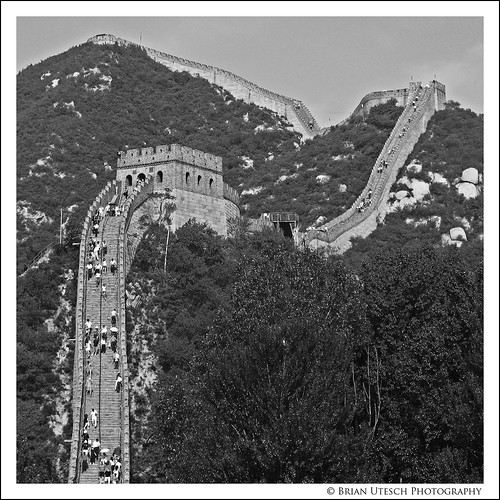

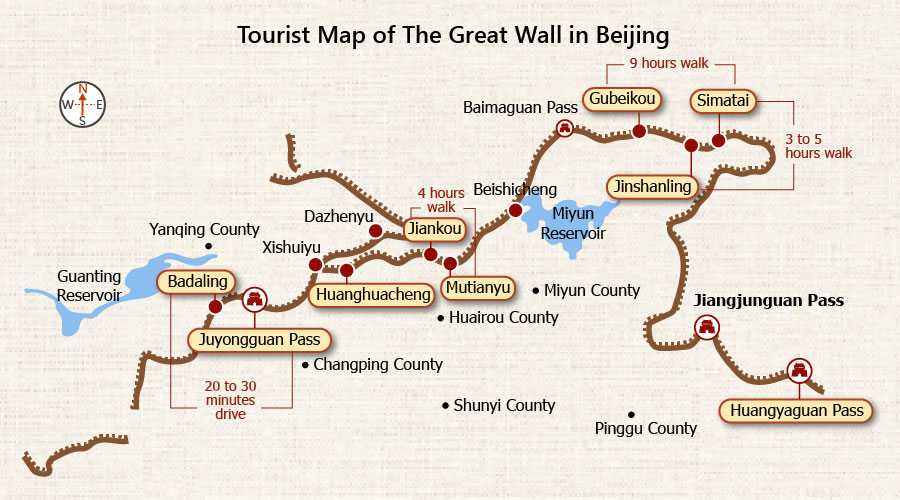
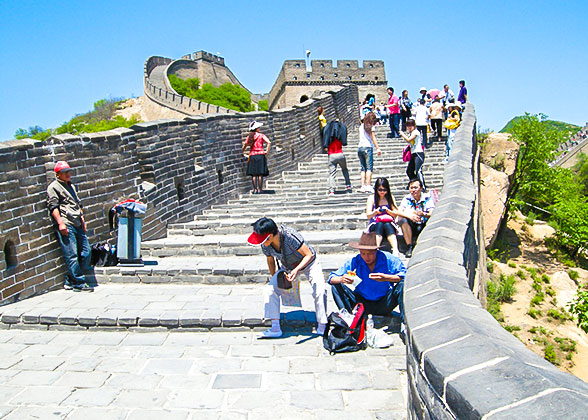 Soldiers made up the main construction group. This was the case with the building of the wall of Northern Qi (550-557). Also, during the Qin Dynasty (221BC - 206BC), 300,000 soldiers were redirected to build the wall after General Meng Tian conquered the Huns. Still, it took nine years to finish the work. In order to take care of the soldiers and make them feel settled, the court even arranged for widows to marry them.
Soldiers made up the main construction group. This was the case with the building of the wall of Northern Qi (550-557). Also, during the Qin Dynasty (221BC - 206BC), 300,000 soldiers were redirected to build the wall after General Meng Tian conquered the Huns. Still, it took nine years to finish the work. In order to take care of the soldiers and make them feel settled, the court even arranged for widows to marry them. Great Wall of China
Great Wall of China 





